Challenges and Benefits: Agile SDLC in Financial Institutions
VerifiedAdded on 2022/10/14
|14
|3974
|3
Report
AI Summary
This report delves into the transition from traditional SDLC methodologies, like Waterfall, to Agile SDLC within financial institutions. It addresses the challenges faced by these institutions, such as regulatory compliance and the need for rigorous testing, and proposes Agile as a suitable methodology to meet the specific needs of the financial sector. The report outlines the benefits of Agile, including reduced project size, continuous development, and the inclusion of quality assurance professionals. It examines the steps involved in adopting Agile, such as dividing projects into smaller modules, utilizing lean requirements, and establishing robust communication platforms. The report also analyzes the challenges, like resistance to change and the sensitivity of financial systems, and provides best practices for successful Agile implementation, focusing on collaboration, providing necessary tools, and stakeholder involvement. The overall goal is to provide guidelines for financial institutions to maximize the benefits of Agile methodology, ultimately improving project execution and delivering high-quality products.
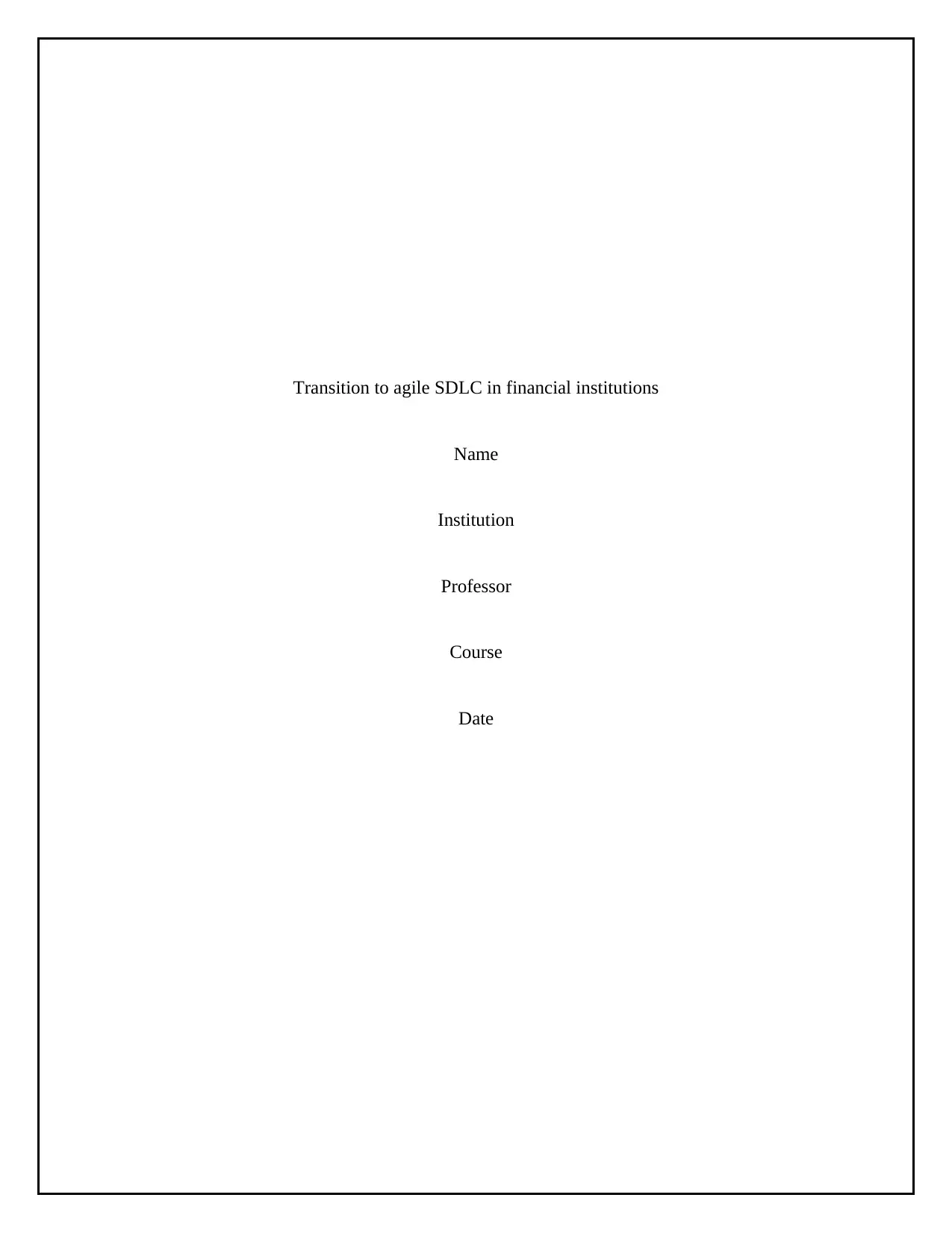
Transition to agile SDLC in financial institutions
Name
Institution
Professor
Course
Date
Name
Institution
Professor
Course
Date
Paraphrase This Document
Need a fresh take? Get an instant paraphrase of this document with our AI Paraphraser
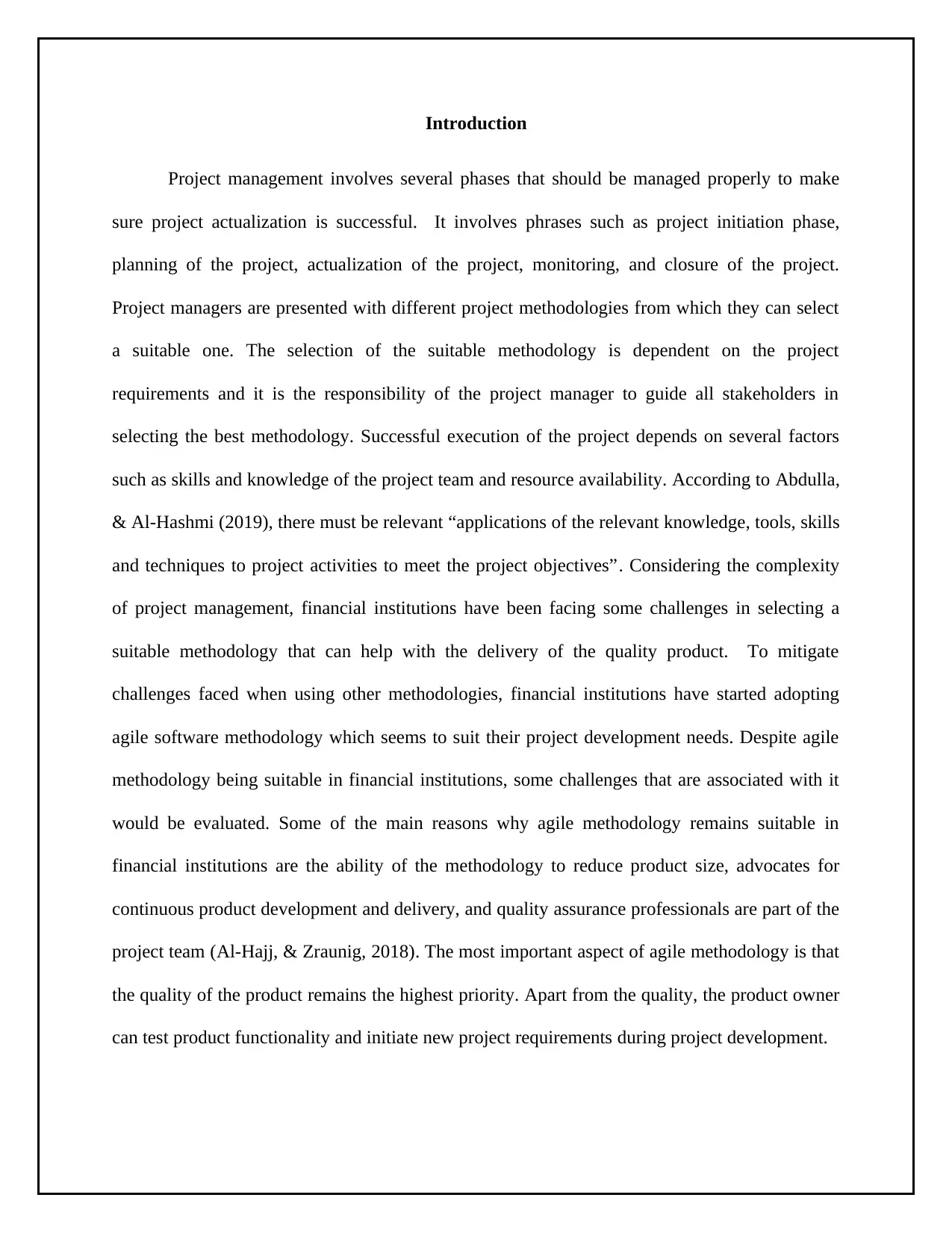
Introduction
Project management involves several phases that should be managed properly to make
sure project actualization is successful. It involves phrases such as project initiation phase,
planning of the project, actualization of the project, monitoring, and closure of the project.
Project managers are presented with different project methodologies from which they can select
a suitable one. The selection of the suitable methodology is dependent on the project
requirements and it is the responsibility of the project manager to guide all stakeholders in
selecting the best methodology. Successful execution of the project depends on several factors
such as skills and knowledge of the project team and resource availability. According to Abdulla,
& Al-Hashmi (2019), there must be relevant “applications of the relevant knowledge, tools, skills
and techniques to project activities to meet the project objectives”. Considering the complexity
of project management, financial institutions have been facing some challenges in selecting a
suitable methodology that can help with the delivery of the quality product. To mitigate
challenges faced when using other methodologies, financial institutions have started adopting
agile software methodology which seems to suit their project development needs. Despite agile
methodology being suitable in financial institutions, some challenges that are associated with it
would be evaluated. Some of the main reasons why agile methodology remains suitable in
financial institutions are the ability of the methodology to reduce product size, advocates for
continuous product development and delivery, and quality assurance professionals are part of the
project team (Al-Hajj, & Zraunig, 2018). The most important aspect of agile methodology is that
the quality of the product remains the highest priority. Apart from the quality, the product owner
can test product functionality and initiate new project requirements during project development.
Project management involves several phases that should be managed properly to make
sure project actualization is successful. It involves phrases such as project initiation phase,
planning of the project, actualization of the project, monitoring, and closure of the project.
Project managers are presented with different project methodologies from which they can select
a suitable one. The selection of the suitable methodology is dependent on the project
requirements and it is the responsibility of the project manager to guide all stakeholders in
selecting the best methodology. Successful execution of the project depends on several factors
such as skills and knowledge of the project team and resource availability. According to Abdulla,
& Al-Hashmi (2019), there must be relevant “applications of the relevant knowledge, tools, skills
and techniques to project activities to meet the project objectives”. Considering the complexity
of project management, financial institutions have been facing some challenges in selecting a
suitable methodology that can help with the delivery of the quality product. To mitigate
challenges faced when using other methodologies, financial institutions have started adopting
agile software methodology which seems to suit their project development needs. Despite agile
methodology being suitable in financial institutions, some challenges that are associated with it
would be evaluated. Some of the main reasons why agile methodology remains suitable in
financial institutions are the ability of the methodology to reduce product size, advocates for
continuous product development and delivery, and quality assurance professionals are part of the
project team (Al-Hajj, & Zraunig, 2018). The most important aspect of agile methodology is that
the quality of the product remains the highest priority. Apart from the quality, the product owner
can test product functionality and initiate new project requirements during project development.
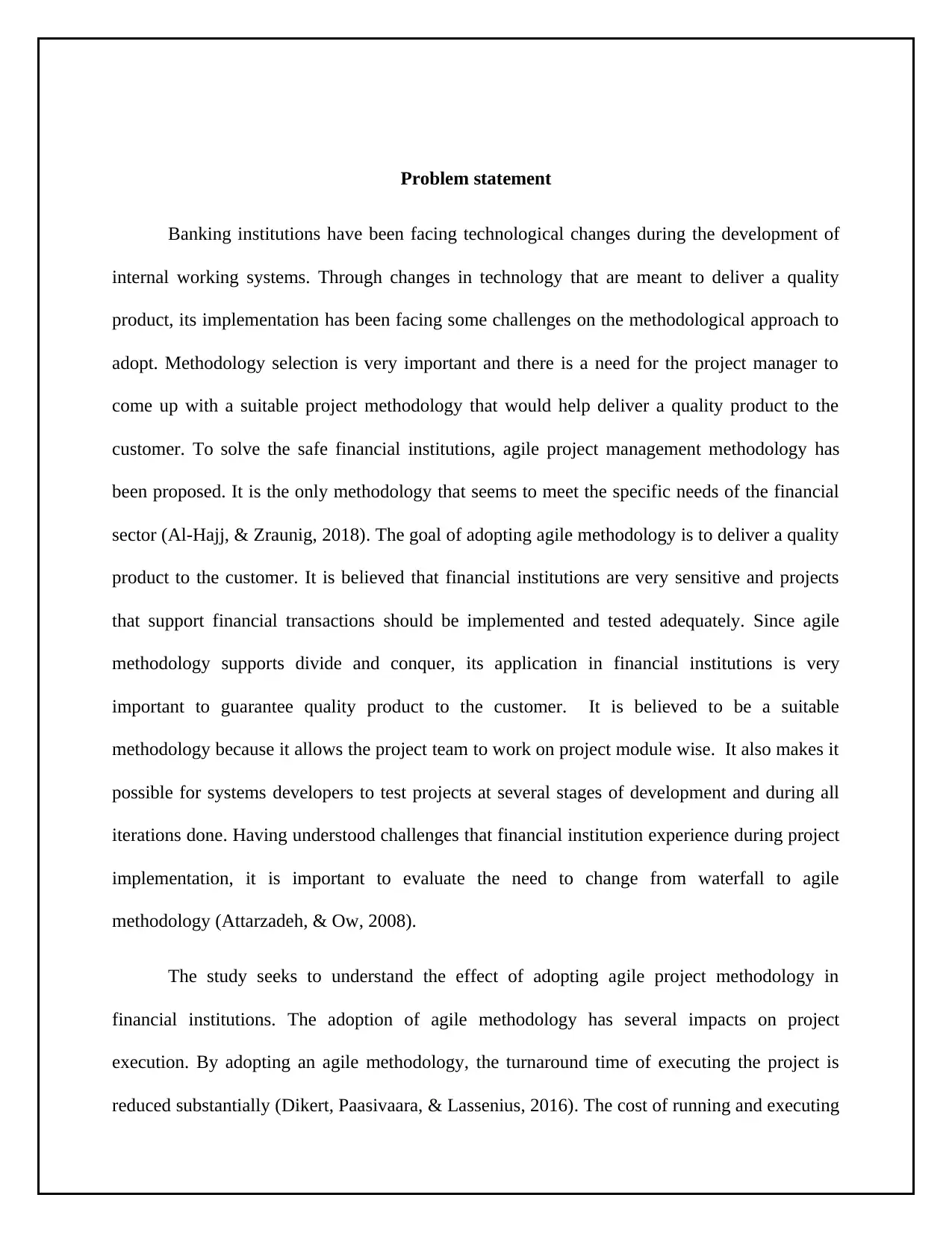
Problem statement
Banking institutions have been facing technological changes during the development of
internal working systems. Through changes in technology that are meant to deliver a quality
product, its implementation has been facing some challenges on the methodological approach to
adopt. Methodology selection is very important and there is a need for the project manager to
come up with a suitable project methodology that would help deliver a quality product to the
customer. To solve the safe financial institutions, agile project management methodology has
been proposed. It is the only methodology that seems to meet the specific needs of the financial
sector (Al-Hajj, & Zraunig, 2018). The goal of adopting agile methodology is to deliver a quality
product to the customer. It is believed that financial institutions are very sensitive and projects
that support financial transactions should be implemented and tested adequately. Since agile
methodology supports divide and conquer, its application in financial institutions is very
important to guarantee quality product to the customer. It is believed to be a suitable
methodology because it allows the project team to work on project module wise. It also makes it
possible for systems developers to test projects at several stages of development and during all
iterations done. Having understood challenges that financial institution experience during project
implementation, it is important to evaluate the need to change from waterfall to agile
methodology (Attarzadeh, & Ow, 2008).
The study seeks to understand the effect of adopting agile project methodology in
financial institutions. The adoption of agile methodology has several impacts on project
execution. By adopting an agile methodology, the turnaround time of executing the project is
reduced substantially (Dikert, Paasivaara, & Lassenius, 2016). The cost of running and executing
Banking institutions have been facing technological changes during the development of
internal working systems. Through changes in technology that are meant to deliver a quality
product, its implementation has been facing some challenges on the methodological approach to
adopt. Methodology selection is very important and there is a need for the project manager to
come up with a suitable project methodology that would help deliver a quality product to the
customer. To solve the safe financial institutions, agile project management methodology has
been proposed. It is the only methodology that seems to meet the specific needs of the financial
sector (Al-Hajj, & Zraunig, 2018). The goal of adopting agile methodology is to deliver a quality
product to the customer. It is believed that financial institutions are very sensitive and projects
that support financial transactions should be implemented and tested adequately. Since agile
methodology supports divide and conquer, its application in financial institutions is very
important to guarantee quality product to the customer. It is believed to be a suitable
methodology because it allows the project team to work on project module wise. It also makes it
possible for systems developers to test projects at several stages of development and during all
iterations done. Having understood challenges that financial institution experience during project
implementation, it is important to evaluate the need to change from waterfall to agile
methodology (Attarzadeh, & Ow, 2008).
The study seeks to understand the effect of adopting agile project methodology in
financial institutions. The adoption of agile methodology has several impacts on project
execution. By adopting an agile methodology, the turnaround time of executing the project is
reduced substantially (Dikert, Paasivaara, & Lassenius, 2016). The cost of running and executing
⊘ This is a preview!⊘
Do you want full access?
Subscribe today to unlock all pages.

Trusted by 1+ million students worldwide
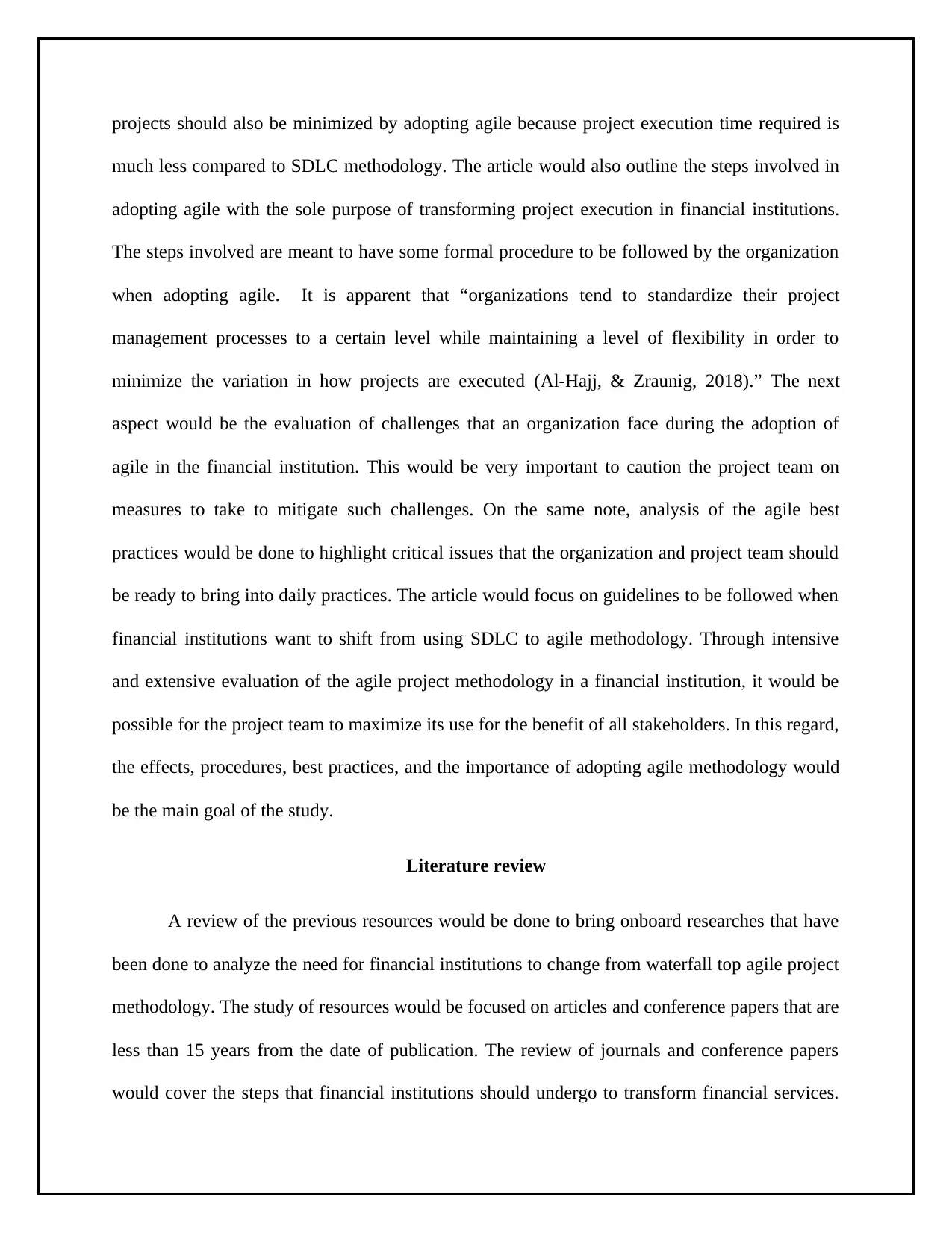
projects should also be minimized by adopting agile because project execution time required is
much less compared to SDLC methodology. The article would also outline the steps involved in
adopting agile with the sole purpose of transforming project execution in financial institutions.
The steps involved are meant to have some formal procedure to be followed by the organization
when adopting agile. It is apparent that “organizations tend to standardize their project
management processes to a certain level while maintaining a level of flexibility in order to
minimize the variation in how projects are executed (Al-Hajj, & Zraunig, 2018).” The next
aspect would be the evaluation of challenges that an organization face during the adoption of
agile in the financial institution. This would be very important to caution the project team on
measures to take to mitigate such challenges. On the same note, analysis of the agile best
practices would be done to highlight critical issues that the organization and project team should
be ready to bring into daily practices. The article would focus on guidelines to be followed when
financial institutions want to shift from using SDLC to agile methodology. Through intensive
and extensive evaluation of the agile project methodology in a financial institution, it would be
possible for the project team to maximize its use for the benefit of all stakeholders. In this regard,
the effects, procedures, best practices, and the importance of adopting agile methodology would
be the main goal of the study.
Literature review
A review of the previous resources would be done to bring onboard researches that have
been done to analyze the need for financial institutions to change from waterfall top agile project
methodology. The study of resources would be focused on articles and conference papers that are
less than 15 years from the date of publication. The review of journals and conference papers
would cover the steps that financial institutions should undergo to transform financial services.
much less compared to SDLC methodology. The article would also outline the steps involved in
adopting agile with the sole purpose of transforming project execution in financial institutions.
The steps involved are meant to have some formal procedure to be followed by the organization
when adopting agile. It is apparent that “organizations tend to standardize their project
management processes to a certain level while maintaining a level of flexibility in order to
minimize the variation in how projects are executed (Al-Hajj, & Zraunig, 2018).” The next
aspect would be the evaluation of challenges that an organization face during the adoption of
agile in the financial institution. This would be very important to caution the project team on
measures to take to mitigate such challenges. On the same note, analysis of the agile best
practices would be done to highlight critical issues that the organization and project team should
be ready to bring into daily practices. The article would focus on guidelines to be followed when
financial institutions want to shift from using SDLC to agile methodology. Through intensive
and extensive evaluation of the agile project methodology in a financial institution, it would be
possible for the project team to maximize its use for the benefit of all stakeholders. In this regard,
the effects, procedures, best practices, and the importance of adopting agile methodology would
be the main goal of the study.
Literature review
A review of the previous resources would be done to bring onboard researches that have
been done to analyze the need for financial institutions to change from waterfall top agile project
methodology. The study of resources would be focused on articles and conference papers that are
less than 15 years from the date of publication. The review of journals and conference papers
would cover the steps that financial institutions should undergo to transform financial services.
Paraphrase This Document
Need a fresh take? Get an instant paraphrase of this document with our AI Paraphraser
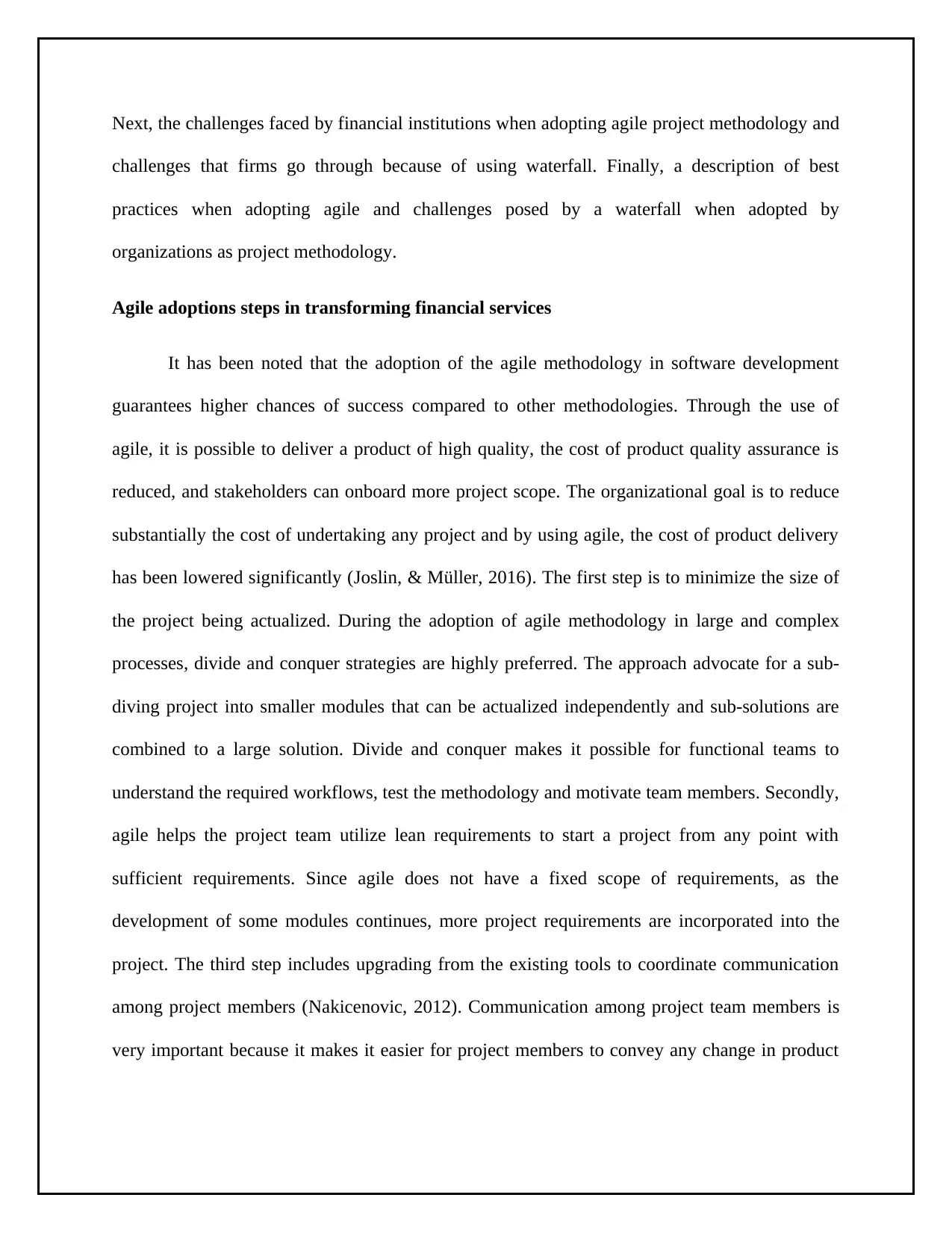
Next, the challenges faced by financial institutions when adopting agile project methodology and
challenges that firms go through because of using waterfall. Finally, a description of best
practices when adopting agile and challenges posed by a waterfall when adopted by
organizations as project methodology.
Agile adoptions steps in transforming financial services
It has been noted that the adoption of the agile methodology in software development
guarantees higher chances of success compared to other methodologies. Through the use of
agile, it is possible to deliver a product of high quality, the cost of product quality assurance is
reduced, and stakeholders can onboard more project scope. The organizational goal is to reduce
substantially the cost of undertaking any project and by using agile, the cost of product delivery
has been lowered significantly (Joslin, & Müller, 2016). The first step is to minimize the size of
the project being actualized. During the adoption of agile methodology in large and complex
processes, divide and conquer strategies are highly preferred. The approach advocate for a sub-
diving project into smaller modules that can be actualized independently and sub-solutions are
combined to a large solution. Divide and conquer makes it possible for functional teams to
understand the required workflows, test the methodology and motivate team members. Secondly,
agile helps the project team utilize lean requirements to start a project from any point with
sufficient requirements. Since agile does not have a fixed scope of requirements, as the
development of some modules continues, more project requirements are incorporated into the
project. The third step includes upgrading from the existing tools to coordinate communication
among project members (Nakicenovic, 2012). Communication among project team members is
very important because it makes it easier for project members to convey any change in product
challenges that firms go through because of using waterfall. Finally, a description of best
practices when adopting agile and challenges posed by a waterfall when adopted by
organizations as project methodology.
Agile adoptions steps in transforming financial services
It has been noted that the adoption of the agile methodology in software development
guarantees higher chances of success compared to other methodologies. Through the use of
agile, it is possible to deliver a product of high quality, the cost of product quality assurance is
reduced, and stakeholders can onboard more project scope. The organizational goal is to reduce
substantially the cost of undertaking any project and by using agile, the cost of product delivery
has been lowered significantly (Joslin, & Müller, 2016). The first step is to minimize the size of
the project being actualized. During the adoption of agile methodology in large and complex
processes, divide and conquer strategies are highly preferred. The approach advocate for a sub-
diving project into smaller modules that can be actualized independently and sub-solutions are
combined to a large solution. Divide and conquer makes it possible for functional teams to
understand the required workflows, test the methodology and motivate team members. Secondly,
agile helps the project team utilize lean requirements to start a project from any point with
sufficient requirements. Since agile does not have a fixed scope of requirements, as the
development of some modules continues, more project requirements are incorporated into the
project. The third step includes upgrading from the existing tools to coordinate communication
among project members (Nakicenovic, 2012). Communication among project team members is
very important because it makes it easier for project members to convey any change in product
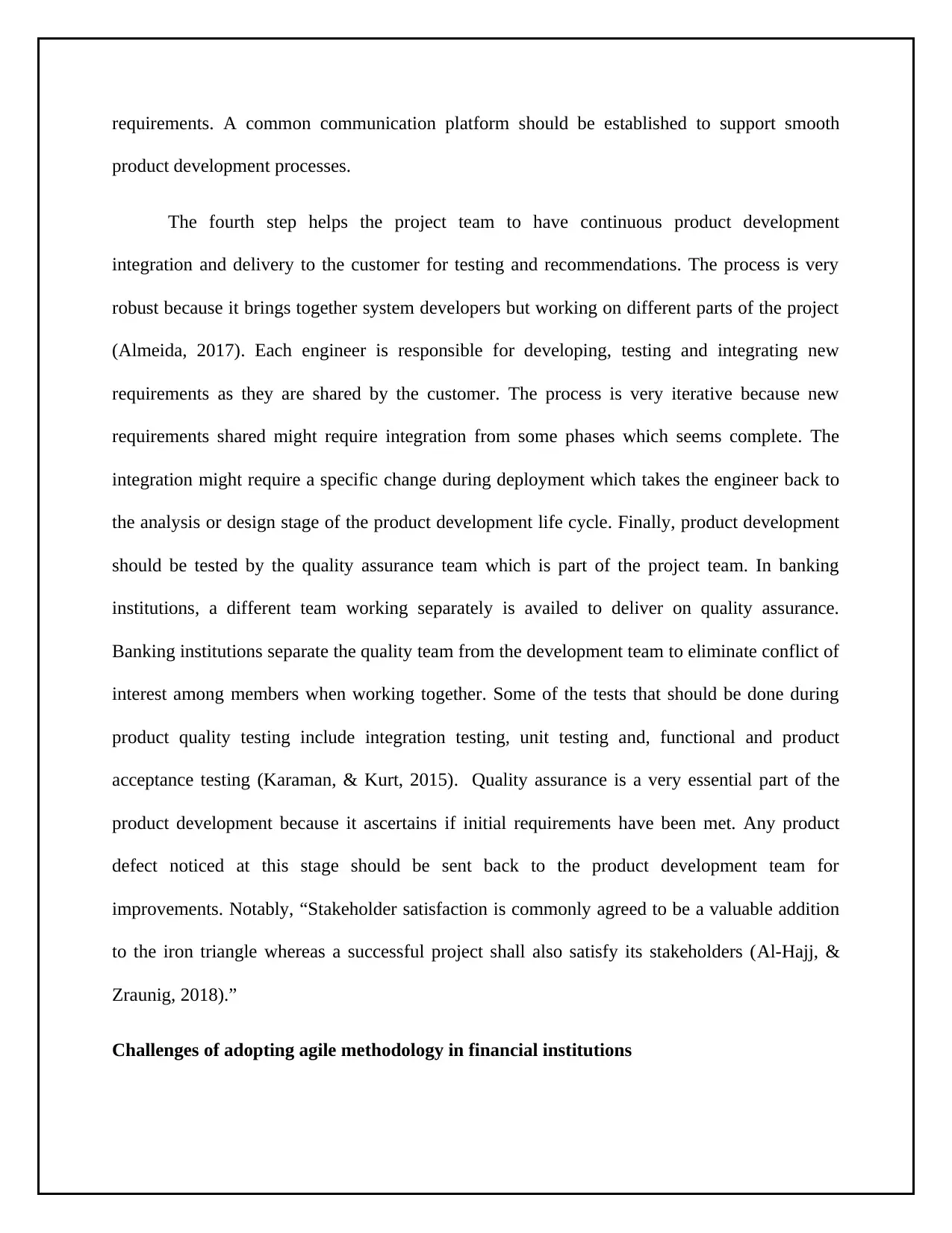
requirements. A common communication platform should be established to support smooth
product development processes.
The fourth step helps the project team to have continuous product development
integration and delivery to the customer for testing and recommendations. The process is very
robust because it brings together system developers but working on different parts of the project
(Almeida, 2017). Each engineer is responsible for developing, testing and integrating new
requirements as they are shared by the customer. The process is very iterative because new
requirements shared might require integration from some phases which seems complete. The
integration might require a specific change during deployment which takes the engineer back to
the analysis or design stage of the product development life cycle. Finally, product development
should be tested by the quality assurance team which is part of the project team. In banking
institutions, a different team working separately is availed to deliver on quality assurance.
Banking institutions separate the quality team from the development team to eliminate conflict of
interest among members when working together. Some of the tests that should be done during
product quality testing include integration testing, unit testing and, functional and product
acceptance testing (Karaman, & Kurt, 2015). Quality assurance is a very essential part of the
product development because it ascertains if initial requirements have been met. Any product
defect noticed at this stage should be sent back to the product development team for
improvements. Notably, “Stakeholder satisfaction is commonly agreed to be a valuable addition
to the iron triangle whereas a successful project shall also satisfy its stakeholders (Al-Hajj, &
Zraunig, 2018).”
Challenges of adopting agile methodology in financial institutions
product development processes.
The fourth step helps the project team to have continuous product development
integration and delivery to the customer for testing and recommendations. The process is very
robust because it brings together system developers but working on different parts of the project
(Almeida, 2017). Each engineer is responsible for developing, testing and integrating new
requirements as they are shared by the customer. The process is very iterative because new
requirements shared might require integration from some phases which seems complete. The
integration might require a specific change during deployment which takes the engineer back to
the analysis or design stage of the product development life cycle. Finally, product development
should be tested by the quality assurance team which is part of the project team. In banking
institutions, a different team working separately is availed to deliver on quality assurance.
Banking institutions separate the quality team from the development team to eliminate conflict of
interest among members when working together. Some of the tests that should be done during
product quality testing include integration testing, unit testing and, functional and product
acceptance testing (Karaman, & Kurt, 2015). Quality assurance is a very essential part of the
product development because it ascertains if initial requirements have been met. Any product
defect noticed at this stage should be sent back to the product development team for
improvements. Notably, “Stakeholder satisfaction is commonly agreed to be a valuable addition
to the iron triangle whereas a successful project shall also satisfy its stakeholders (Al-Hajj, &
Zraunig, 2018).”
Challenges of adopting agile methodology in financial institutions
⊘ This is a preview!⊘
Do you want full access?
Subscribe today to unlock all pages.

Trusted by 1+ million students worldwide
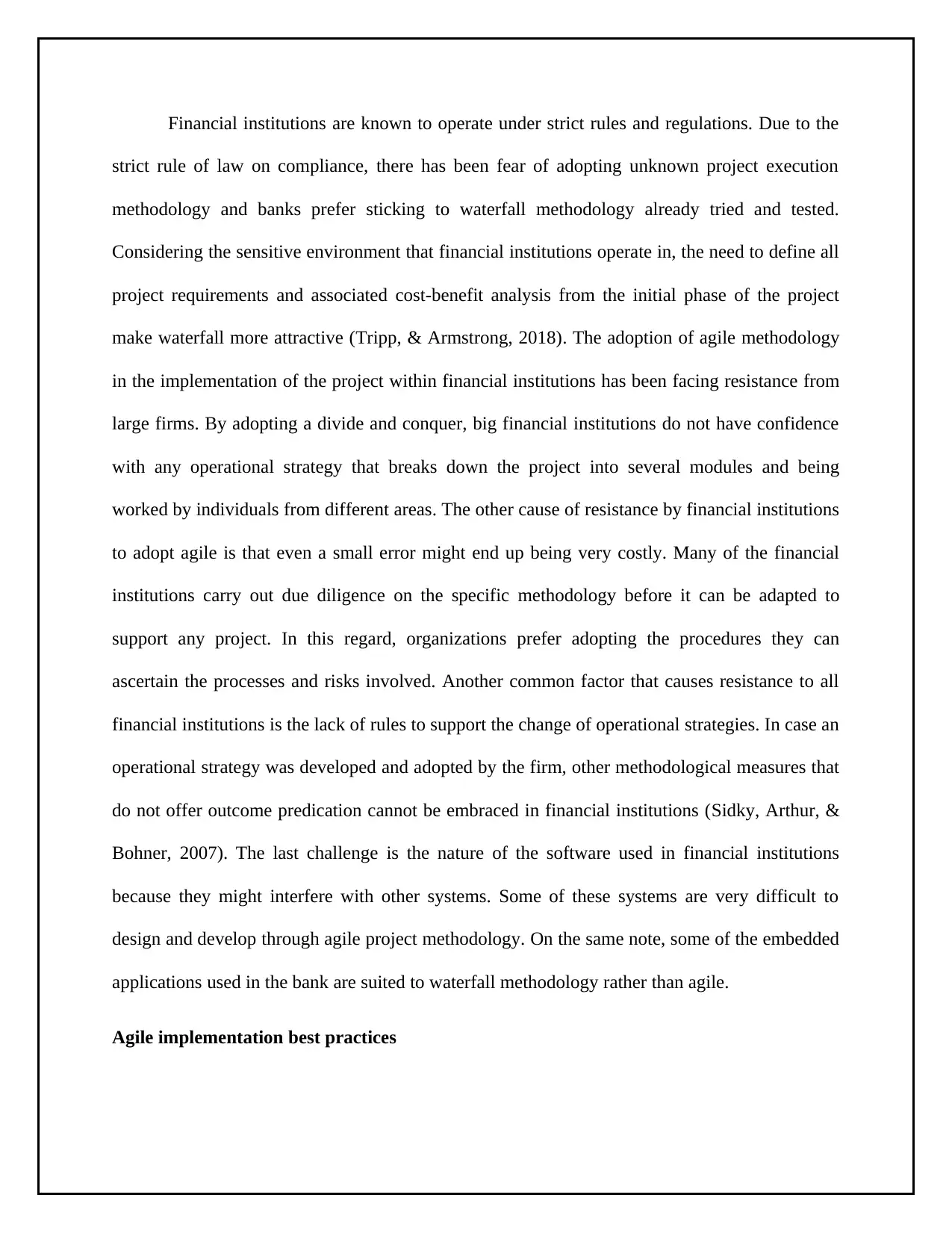
Financial institutions are known to operate under strict rules and regulations. Due to the
strict rule of law on compliance, there has been fear of adopting unknown project execution
methodology and banks prefer sticking to waterfall methodology already tried and tested.
Considering the sensitive environment that financial institutions operate in, the need to define all
project requirements and associated cost-benefit analysis from the initial phase of the project
make waterfall more attractive (Tripp, & Armstrong, 2018). The adoption of agile methodology
in the implementation of the project within financial institutions has been facing resistance from
large firms. By adopting a divide and conquer, big financial institutions do not have confidence
with any operational strategy that breaks down the project into several modules and being
worked by individuals from different areas. The other cause of resistance by financial institutions
to adopt agile is that even a small error might end up being very costly. Many of the financial
institutions carry out due diligence on the specific methodology before it can be adapted to
support any project. In this regard, organizations prefer adopting the procedures they can
ascertain the processes and risks involved. Another common factor that causes resistance to all
financial institutions is the lack of rules to support the change of operational strategies. In case an
operational strategy was developed and adopted by the firm, other methodological measures that
do not offer outcome predication cannot be embraced in financial institutions (Sidky, Arthur, &
Bohner, 2007). The last challenge is the nature of the software used in financial institutions
because they might interfere with other systems. Some of these systems are very difficult to
design and develop through agile project methodology. On the same note, some of the embedded
applications used in the bank are suited to waterfall methodology rather than agile.
Agile implementation best practices
strict rule of law on compliance, there has been fear of adopting unknown project execution
methodology and banks prefer sticking to waterfall methodology already tried and tested.
Considering the sensitive environment that financial institutions operate in, the need to define all
project requirements and associated cost-benefit analysis from the initial phase of the project
make waterfall more attractive (Tripp, & Armstrong, 2018). The adoption of agile methodology
in the implementation of the project within financial institutions has been facing resistance from
large firms. By adopting a divide and conquer, big financial institutions do not have confidence
with any operational strategy that breaks down the project into several modules and being
worked by individuals from different areas. The other cause of resistance by financial institutions
to adopt agile is that even a small error might end up being very costly. Many of the financial
institutions carry out due diligence on the specific methodology before it can be adapted to
support any project. In this regard, organizations prefer adopting the procedures they can
ascertain the processes and risks involved. Another common factor that causes resistance to all
financial institutions is the lack of rules to support the change of operational strategies. In case an
operational strategy was developed and adopted by the firm, other methodological measures that
do not offer outcome predication cannot be embraced in financial institutions (Sidky, Arthur, &
Bohner, 2007). The last challenge is the nature of the software used in financial institutions
because they might interfere with other systems. Some of these systems are very difficult to
design and develop through agile project methodology. On the same note, some of the embedded
applications used in the bank are suited to waterfall methodology rather than agile.
Agile implementation best practices
Paraphrase This Document
Need a fresh take? Get an instant paraphrase of this document with our AI Paraphraser
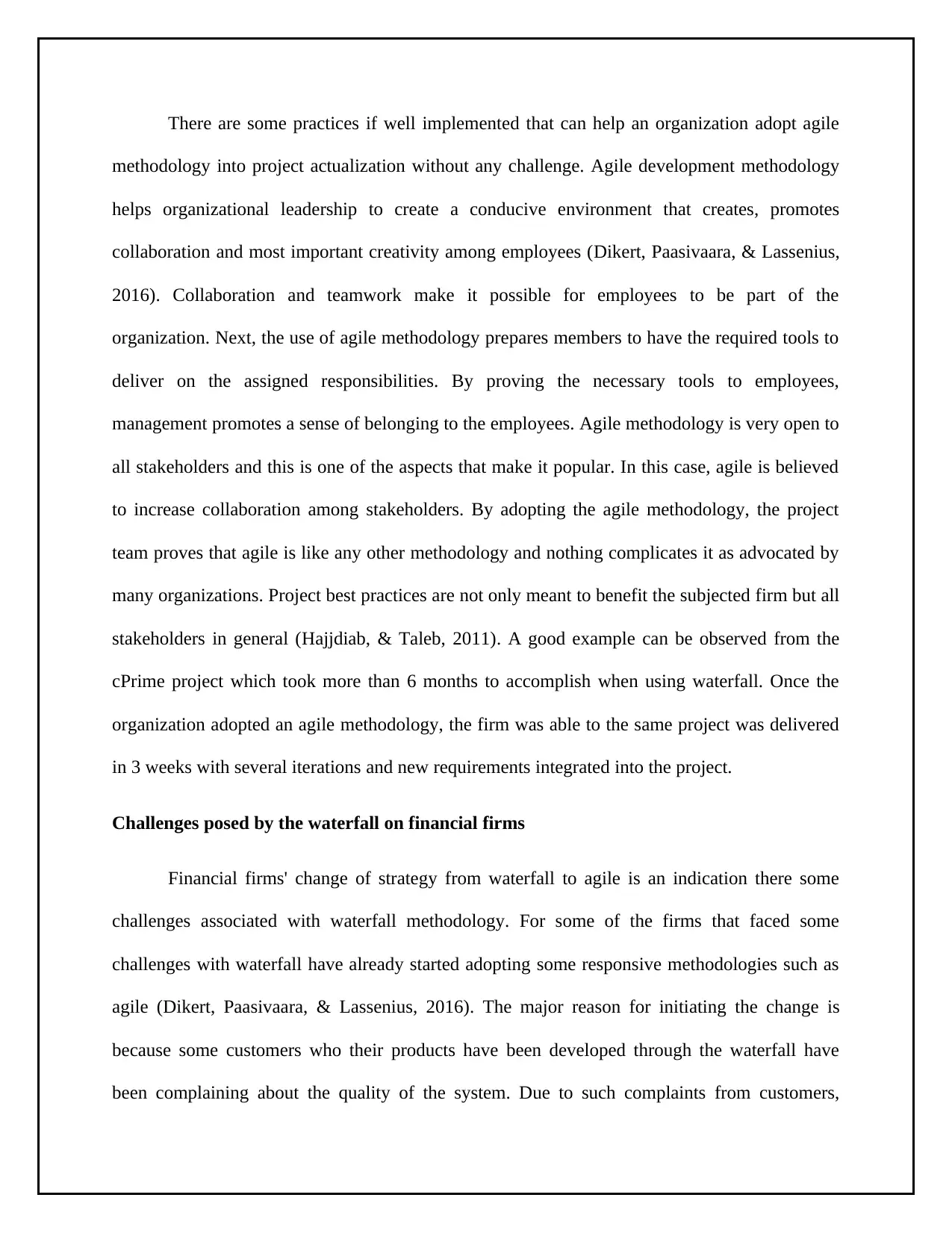
There are some practices if well implemented that can help an organization adopt agile
methodology into project actualization without any challenge. Agile development methodology
helps organizational leadership to create a conducive environment that creates, promotes
collaboration and most important creativity among employees (Dikert, Paasivaara, & Lassenius,
2016). Collaboration and teamwork make it possible for employees to be part of the
organization. Next, the use of agile methodology prepares members to have the required tools to
deliver on the assigned responsibilities. By proving the necessary tools to employees,
management promotes a sense of belonging to the employees. Agile methodology is very open to
all stakeholders and this is one of the aspects that make it popular. In this case, agile is believed
to increase collaboration among stakeholders. By adopting the agile methodology, the project
team proves that agile is like any other methodology and nothing complicates it as advocated by
many organizations. Project best practices are not only meant to benefit the subjected firm but all
stakeholders in general (Hajjdiab, & Taleb, 2011). A good example can be observed from the
cPrime project which took more than 6 months to accomplish when using waterfall. Once the
organization adopted an agile methodology, the firm was able to the same project was delivered
in 3 weeks with several iterations and new requirements integrated into the project.
Challenges posed by the waterfall on financial firms
Financial firms' change of strategy from waterfall to agile is an indication there some
challenges associated with waterfall methodology. For some of the firms that faced some
challenges with waterfall have already started adopting some responsive methodologies such as
agile (Dikert, Paasivaara, & Lassenius, 2016). The major reason for initiating the change is
because some customers who their products have been developed through the waterfall have
been complaining about the quality of the system. Due to such complaints from customers,
methodology into project actualization without any challenge. Agile development methodology
helps organizational leadership to create a conducive environment that creates, promotes
collaboration and most important creativity among employees (Dikert, Paasivaara, & Lassenius,
2016). Collaboration and teamwork make it possible for employees to be part of the
organization. Next, the use of agile methodology prepares members to have the required tools to
deliver on the assigned responsibilities. By proving the necessary tools to employees,
management promotes a sense of belonging to the employees. Agile methodology is very open to
all stakeholders and this is one of the aspects that make it popular. In this case, agile is believed
to increase collaboration among stakeholders. By adopting the agile methodology, the project
team proves that agile is like any other methodology and nothing complicates it as advocated by
many organizations. Project best practices are not only meant to benefit the subjected firm but all
stakeholders in general (Hajjdiab, & Taleb, 2011). A good example can be observed from the
cPrime project which took more than 6 months to accomplish when using waterfall. Once the
organization adopted an agile methodology, the firm was able to the same project was delivered
in 3 weeks with several iterations and new requirements integrated into the project.
Challenges posed by the waterfall on financial firms
Financial firms' change of strategy from waterfall to agile is an indication there some
challenges associated with waterfall methodology. For some of the firms that faced some
challenges with waterfall have already started adopting some responsive methodologies such as
agile (Dikert, Paasivaara, & Lassenius, 2016). The major reason for initiating the change is
because some customers who their products have been developed through the waterfall have
been complaining about the quality of the system. Due to such complaints from customers,
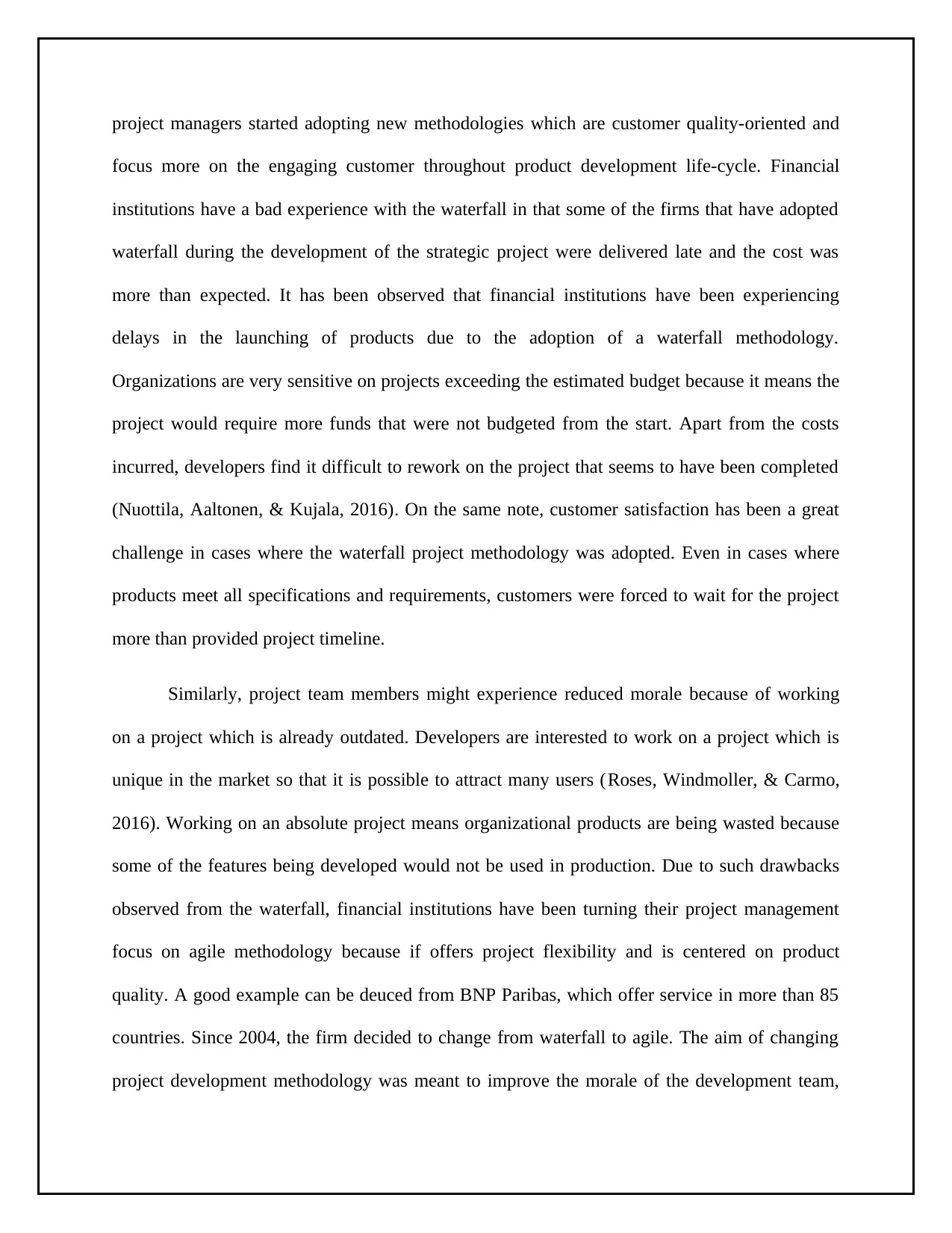
project managers started adopting new methodologies which are customer quality-oriented and
focus more on the engaging customer throughout product development life-cycle. Financial
institutions have a bad experience with the waterfall in that some of the firms that have adopted
waterfall during the development of the strategic project were delivered late and the cost was
more than expected. It has been observed that financial institutions have been experiencing
delays in the launching of products due to the adoption of a waterfall methodology.
Organizations are very sensitive on projects exceeding the estimated budget because it means the
project would require more funds that were not budgeted from the start. Apart from the costs
incurred, developers find it difficult to rework on the project that seems to have been completed
(Nuottila, Aaltonen, & Kujala, 2016). On the same note, customer satisfaction has been a great
challenge in cases where the waterfall project methodology was adopted. Even in cases where
products meet all specifications and requirements, customers were forced to wait for the project
more than provided project timeline.
Similarly, project team members might experience reduced morale because of working
on a project which is already outdated. Developers are interested to work on a project which is
unique in the market so that it is possible to attract many users (Roses, Windmoller, & Carmo,
2016). Working on an absolute project means organizational products are being wasted because
some of the features being developed would not be used in production. Due to such drawbacks
observed from the waterfall, financial institutions have been turning their project management
focus on agile methodology because if offers project flexibility and is centered on product
quality. A good example can be deuced from BNP Paribas, which offer service in more than 85
countries. Since 2004, the firm decided to change from waterfall to agile. The aim of changing
project development methodology was meant to improve the morale of the development team,
focus more on the engaging customer throughout product development life-cycle. Financial
institutions have a bad experience with the waterfall in that some of the firms that have adopted
waterfall during the development of the strategic project were delivered late and the cost was
more than expected. It has been observed that financial institutions have been experiencing
delays in the launching of products due to the adoption of a waterfall methodology.
Organizations are very sensitive on projects exceeding the estimated budget because it means the
project would require more funds that were not budgeted from the start. Apart from the costs
incurred, developers find it difficult to rework on the project that seems to have been completed
(Nuottila, Aaltonen, & Kujala, 2016). On the same note, customer satisfaction has been a great
challenge in cases where the waterfall project methodology was adopted. Even in cases where
products meet all specifications and requirements, customers were forced to wait for the project
more than provided project timeline.
Similarly, project team members might experience reduced morale because of working
on a project which is already outdated. Developers are interested to work on a project which is
unique in the market so that it is possible to attract many users (Roses, Windmoller, & Carmo,
2016). Working on an absolute project means organizational products are being wasted because
some of the features being developed would not be used in production. Due to such drawbacks
observed from the waterfall, financial institutions have been turning their project management
focus on agile methodology because if offers project flexibility and is centered on product
quality. A good example can be deuced from BNP Paribas, which offer service in more than 85
countries. Since 2004, the firm decided to change from waterfall to agile. The aim of changing
project development methodology was meant to improve the morale of the development team,
⊘ This is a preview!⊘
Do you want full access?
Subscribe today to unlock all pages.

Trusted by 1+ million students worldwide
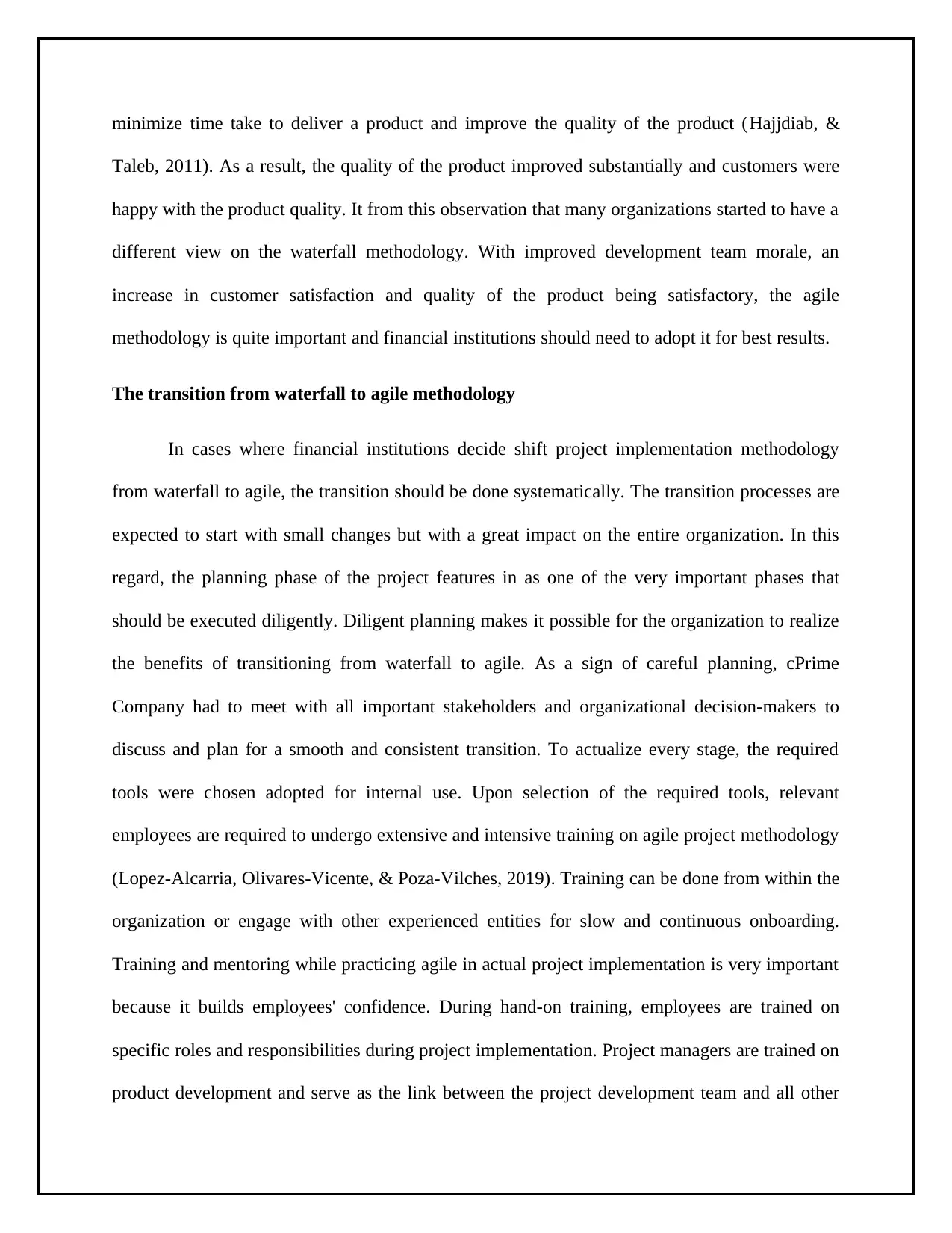
minimize time take to deliver a product and improve the quality of the product (Hajjdiab, &
Taleb, 2011). As a result, the quality of the product improved substantially and customers were
happy with the product quality. It from this observation that many organizations started to have a
different view on the waterfall methodology. With improved development team morale, an
increase in customer satisfaction and quality of the product being satisfactory, the agile
methodology is quite important and financial institutions should need to adopt it for best results.
The transition from waterfall to agile methodology
In cases where financial institutions decide shift project implementation methodology
from waterfall to agile, the transition should be done systematically. The transition processes are
expected to start with small changes but with a great impact on the entire organization. In this
regard, the planning phase of the project features in as one of the very important phases that
should be executed diligently. Diligent planning makes it possible for the organization to realize
the benefits of transitioning from waterfall to agile. As a sign of careful planning, cPrime
Company had to meet with all important stakeholders and organizational decision-makers to
discuss and plan for a smooth and consistent transition. To actualize every stage, the required
tools were chosen adopted for internal use. Upon selection of the required tools, relevant
employees are required to undergo extensive and intensive training on agile project methodology
(Lopez-Alcarria, Olivares-Vicente, & Poza-Vilches, 2019). Training can be done from within the
organization or engage with other experienced entities for slow and continuous onboarding.
Training and mentoring while practicing agile in actual project implementation is very important
because it builds employees' confidence. During hand-on training, employees are trained on
specific roles and responsibilities during project implementation. Project managers are trained on
product development and serve as the link between the project development team and all other
Taleb, 2011). As a result, the quality of the product improved substantially and customers were
happy with the product quality. It from this observation that many organizations started to have a
different view on the waterfall methodology. With improved development team morale, an
increase in customer satisfaction and quality of the product being satisfactory, the agile
methodology is quite important and financial institutions should need to adopt it for best results.
The transition from waterfall to agile methodology
In cases where financial institutions decide shift project implementation methodology
from waterfall to agile, the transition should be done systematically. The transition processes are
expected to start with small changes but with a great impact on the entire organization. In this
regard, the planning phase of the project features in as one of the very important phases that
should be executed diligently. Diligent planning makes it possible for the organization to realize
the benefits of transitioning from waterfall to agile. As a sign of careful planning, cPrime
Company had to meet with all important stakeholders and organizational decision-makers to
discuss and plan for a smooth and consistent transition. To actualize every stage, the required
tools were chosen adopted for internal use. Upon selection of the required tools, relevant
employees are required to undergo extensive and intensive training on agile project methodology
(Lopez-Alcarria, Olivares-Vicente, & Poza-Vilches, 2019). Training can be done from within the
organization or engage with other experienced entities for slow and continuous onboarding.
Training and mentoring while practicing agile in actual project implementation is very important
because it builds employees' confidence. During hand-on training, employees are trained on
specific roles and responsibilities during project implementation. Project managers are trained on
product development and serve as the link between the project development team and all other
Paraphrase This Document
Need a fresh take? Get an instant paraphrase of this document with our AI Paraphraser
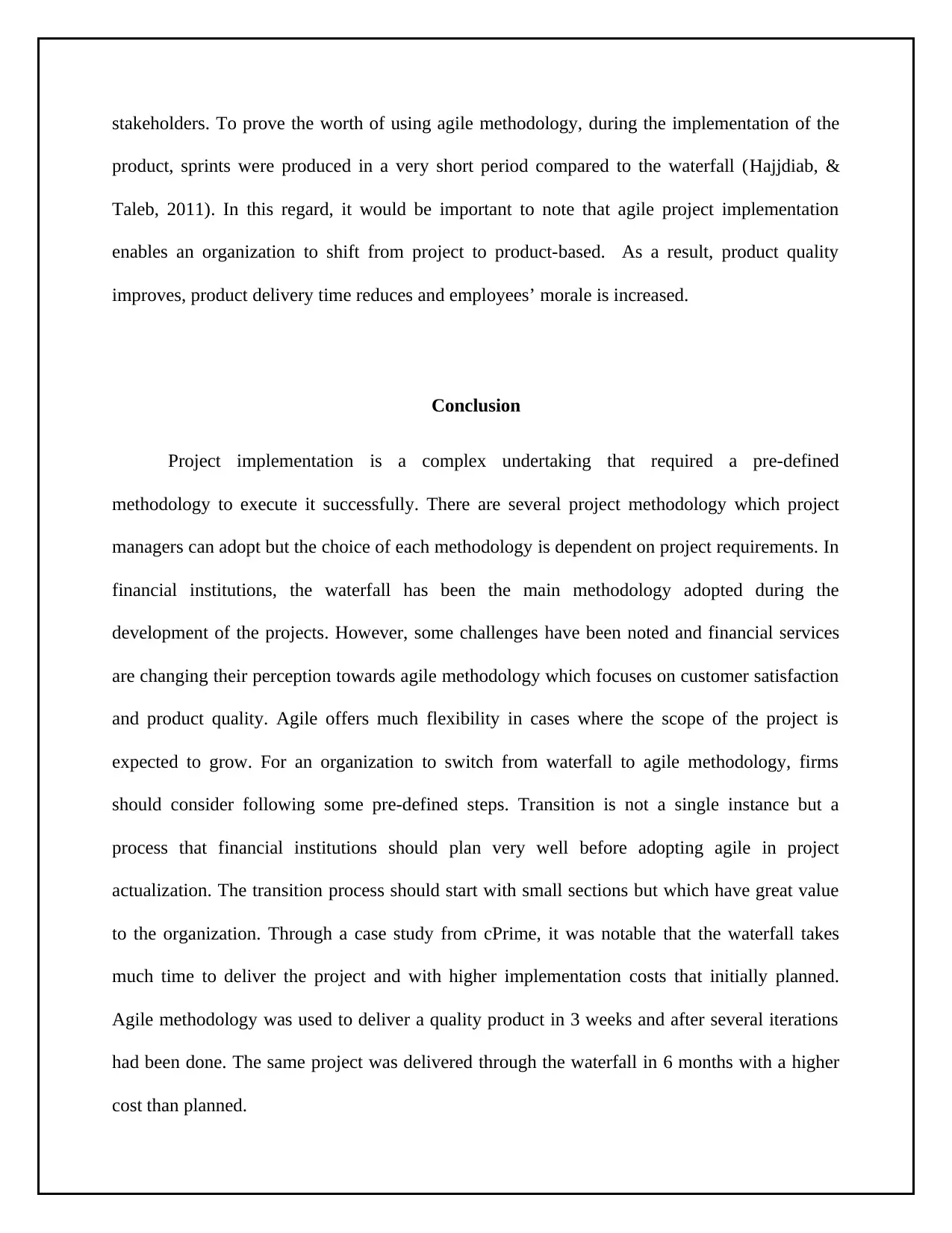
stakeholders. To prove the worth of using agile methodology, during the implementation of the
product, sprints were produced in a very short period compared to the waterfall (Hajjdiab, &
Taleb, 2011). In this regard, it would be important to note that agile project implementation
enables an organization to shift from project to product-based. As a result, product quality
improves, product delivery time reduces and employees’ morale is increased.
Conclusion
Project implementation is a complex undertaking that required a pre-defined
methodology to execute it successfully. There are several project methodology which project
managers can adopt but the choice of each methodology is dependent on project requirements. In
financial institutions, the waterfall has been the main methodology adopted during the
development of the projects. However, some challenges have been noted and financial services
are changing their perception towards agile methodology which focuses on customer satisfaction
and product quality. Agile offers much flexibility in cases where the scope of the project is
expected to grow. For an organization to switch from waterfall to agile methodology, firms
should consider following some pre-defined steps. Transition is not a single instance but a
process that financial institutions should plan very well before adopting agile in project
actualization. The transition process should start with small sections but which have great value
to the organization. Through a case study from cPrime, it was notable that the waterfall takes
much time to deliver the project and with higher implementation costs that initially planned.
Agile methodology was used to deliver a quality product in 3 weeks and after several iterations
had been done. The same project was delivered through the waterfall in 6 months with a higher
cost than planned.
product, sprints were produced in a very short period compared to the waterfall (Hajjdiab, &
Taleb, 2011). In this regard, it would be important to note that agile project implementation
enables an organization to shift from project to product-based. As a result, product quality
improves, product delivery time reduces and employees’ morale is increased.
Conclusion
Project implementation is a complex undertaking that required a pre-defined
methodology to execute it successfully. There are several project methodology which project
managers can adopt but the choice of each methodology is dependent on project requirements. In
financial institutions, the waterfall has been the main methodology adopted during the
development of the projects. However, some challenges have been noted and financial services
are changing their perception towards agile methodology which focuses on customer satisfaction
and product quality. Agile offers much flexibility in cases where the scope of the project is
expected to grow. For an organization to switch from waterfall to agile methodology, firms
should consider following some pre-defined steps. Transition is not a single instance but a
process that financial institutions should plan very well before adopting agile in project
actualization. The transition process should start with small sections but which have great value
to the organization. Through a case study from cPrime, it was notable that the waterfall takes
much time to deliver the project and with higher implementation costs that initially planned.
Agile methodology was used to deliver a quality product in 3 weeks and after several iterations
had been done. The same project was delivered through the waterfall in 6 months with a higher
cost than planned.
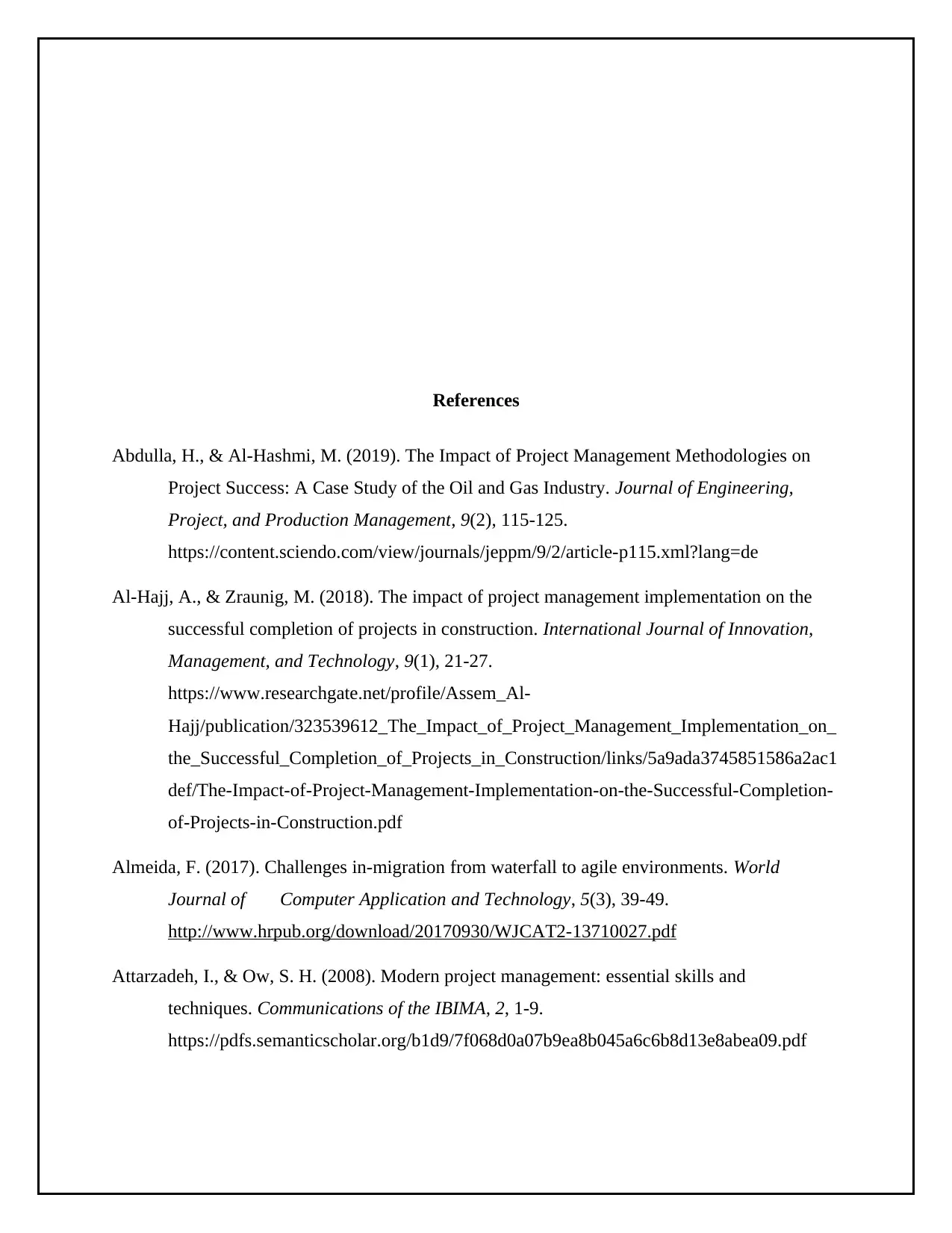
References
Abdulla, H., & Al-Hashmi, M. (2019). The Impact of Project Management Methodologies on
Project Success: A Case Study of the Oil and Gas Industry. Journal of Engineering,
Project, and Production Management, 9(2), 115-125.
https://content.sciendo.com/view/journals/jeppm/9/2/article-p115.xml?lang=de
Al-Hajj, A., & Zraunig, M. (2018). The impact of project management implementation on the
successful completion of projects in construction. International Journal of Innovation,
Management, and Technology, 9(1), 21-27.
https://www.researchgate.net/profile/Assem_Al-
Hajj/publication/323539612_The_Impact_of_Project_Management_Implementation_on_
the_Successful_Completion_of_Projects_in_Construction/links/5a9ada3745851586a2ac1
def/The-Impact-of-Project-Management-Implementation-on-the-Successful-Completion-
of-Projects-in-Construction.pdf
Almeida, F. (2017). Challenges in-migration from waterfall to agile environments. World
Journal of Computer Application and Technology, 5(3), 39-49.
http://www.hrpub.org/download/20170930/WJCAT2-13710027.pdf
Attarzadeh, I., & Ow, S. H. (2008). Modern project management: essential skills and
techniques. Communications of the IBIMA, 2, 1-9.
https://pdfs.semanticscholar.org/b1d9/7f068d0a07b9ea8b045a6c6b8d13e8abea09.pdf
Abdulla, H., & Al-Hashmi, M. (2019). The Impact of Project Management Methodologies on
Project Success: A Case Study of the Oil and Gas Industry. Journal of Engineering,
Project, and Production Management, 9(2), 115-125.
https://content.sciendo.com/view/journals/jeppm/9/2/article-p115.xml?lang=de
Al-Hajj, A., & Zraunig, M. (2018). The impact of project management implementation on the
successful completion of projects in construction. International Journal of Innovation,
Management, and Technology, 9(1), 21-27.
https://www.researchgate.net/profile/Assem_Al-
Hajj/publication/323539612_The_Impact_of_Project_Management_Implementation_on_
the_Successful_Completion_of_Projects_in_Construction/links/5a9ada3745851586a2ac1
def/The-Impact-of-Project-Management-Implementation-on-the-Successful-Completion-
of-Projects-in-Construction.pdf
Almeida, F. (2017). Challenges in-migration from waterfall to agile environments. World
Journal of Computer Application and Technology, 5(3), 39-49.
http://www.hrpub.org/download/20170930/WJCAT2-13710027.pdf
Attarzadeh, I., & Ow, S. H. (2008). Modern project management: essential skills and
techniques. Communications of the IBIMA, 2, 1-9.
https://pdfs.semanticscholar.org/b1d9/7f068d0a07b9ea8b045a6c6b8d13e8abea09.pdf
⊘ This is a preview!⊘
Do you want full access?
Subscribe today to unlock all pages.

Trusted by 1+ million students worldwide
1 out of 14
Related Documents
Your All-in-One AI-Powered Toolkit for Academic Success.
+13062052269
info@desklib.com
Available 24*7 on WhatsApp / Email
![[object Object]](/_next/static/media/star-bottom.7253800d.svg)
Unlock your academic potential
Copyright © 2020–2025 A2Z Services. All Rights Reserved. Developed and managed by ZUCOL.





